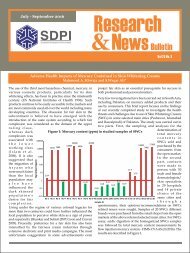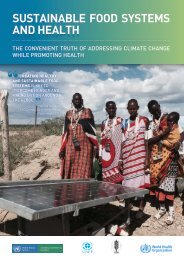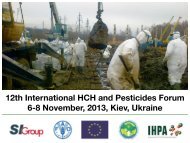Women and Chemicals
WomenAndChemicals_PublicationIWD2016
WomenAndChemicals_PublicationIWD2016
Create successful ePaper yourself
Turn your PDF publications into a flip-book with our unique Google optimized e-Paper software.
Where are women exposed to chemicals?<br />
These substances are used for the whole plastic production process<br />
<strong>and</strong> are linked to various diseases. Some of the substances<br />
are known to have a mutagenic effect <strong>and</strong> can lead to cancer.<br />
Some are suspected of being mutagenic. Others have endocrine<br />
disrupting effects that can promote cancer <strong>and</strong> other illnesses<br />
linked to the endocrine system like reproductive health impacts.<br />
A study shows that the exposure in the plastic industry poses<br />
women at disproportionate risk. It also shows the need for regulatory<br />
action. 44 <strong>Women</strong> in the plastics industry have a significantly<br />
higher body burden than unexposed workers <strong>and</strong> the general<br />
population. A Canadian study shows that women working in<br />
automotive plastics <strong>and</strong> food canning industries have fivefold<br />
increase in pre-menopausal breast cancer. 45 The study also claims<br />
that “Despite concern about the harmful effects of substances<br />
contained in various plastic consumer products, little attention<br />
has focused on the more heavily exposed women working in the<br />
plastics industry.“ 46<br />
<strong>Women</strong> in services<br />
Besides agriculture, services are one of the main working sectors<br />
for women. The ILO estimates that 47 per cent of employed<br />
women worldwide work in services 47 such as health care, retail<br />
<strong>and</strong> education. <strong>Women</strong> in typical female professions, like hairdressers,<br />
nurses <strong>and</strong> cleaners, are among the most exposed in<br />
this sector. The material they use such as medical devices, shampoo,<br />
etc. are mainly chosen <strong>and</strong> purchased by the companies<br />
they work for. Often the employers <strong>and</strong> the employees have little<br />
to no knowledge about the substances in the products they use,<br />
since they are rarely labelled, ingredients are not disclosed or<br />
specific trainings are not in place.<br />
<strong>Women</strong> in the health sector<br />
Nurses are exposed constantly to toxins in disinfectants <strong>and</strong> stylizing<br />
agents, additionally they can be in contact with hazardous<br />
chemicals in medical devices, chemotherapy, pesticides, <strong>and</strong><br />
other tools <strong>and</strong> materials. This exposure can lead to serious<br />
health problems. Common chemicals to which women in the<br />
health sector are exposed to are: BPA, PVC, triclosan, PBDE,<br />
phthalates, perfluorinated compounds <strong>and</strong> mercury. All of those<br />
chemicals can be found in blood, urine <strong>and</strong> hair samples of female<br />
nurses <strong>and</strong> doctors. 48 Nurses report that the four common<br />
exposures are h<strong>and</strong> <strong>and</strong> skin disinfectants, medications, housekeeping<br />
chemicals <strong>and</strong> latex. 49 Studies show that among nursing<br />
professionals, workplace exposures to cleaning products <strong>and</strong><br />
disinfectants increase the risk of new-onset asthma. 50 A two-fold<br />
increased risk of late spontaneous abortion (12-20 weeks) among<br />
nurses was associated with exposure to sterilizing agents. 51 In the<br />
US, nurses teamed up to dem<strong>and</strong> better chemicals regulation<br />
protecting them from harmful chemicals. 52 Several projects <strong>and</strong><br />
activities from civil society <strong>and</strong> trade unions try to achieve the<br />
same goal. The NGO Health Care Without Harm (HCWH) runs<br />
several campaigns <strong>and</strong> projects to make health care greener <strong>and</strong><br />
healthier for professionals <strong>and</strong> patients. 53<br />
<strong>Women</strong> as hairdressers<br />
Hairdressers are exposed to harmful substances in a number of<br />
products like hair dyes, bleaching agents, permanent waves solutions,<br />
hair shampoos <strong>and</strong> conditioners, hair spray <strong>and</strong> perfumes.<br />
Common substances found in those products are: ammonia<br />
<strong>and</strong> ammonia derivatives, formaldehyde releasers, allergens,<br />
acrylate copolymers in aerosol-form products, <strong>and</strong> EDCs<br />
such as parabens <strong>and</strong> UV-filters. Hair dyes typically contain the<br />
Call of female waste pickers in South America<br />
March 8 th : <strong>Women</strong> in the struggle for inclusive recycling<br />
“For women waste pickers, March 8 is a day of struggle – a struggle<br />
for inclusive recycling <strong>and</strong> for the end of inequality in recycling.<br />
Inclusive recycling is recycling by the waste pickers, in their<br />
associations <strong>and</strong> cooperatives. It underst<strong>and</strong>s the entire production<br />
process: public service provision, segregation of waste, industrialization<br />
of recyclables. Inclusive recycling is already a practice<br />
in many places around the country, but many waste pickers<br />
continue to suffer exploration <strong>and</strong> lack of payment for the service<br />
they provide. When things get difficult, we women bend over<br />
backwards to make sure nothing is missing at home. That’s why<br />
we are fighting for 100 per cent recycling with 100 per cent social<br />
inclusion. We are fighting for contracts based on a new model of<br />
integrated solid waste management – a system that promotes<br />
waste management with public participation <strong>and</strong> social inclu-<br />
sion. We say no to incineration, no to privatization. We say no to<br />
the “containerization” of waste, because we don’t believe “makeovers”<br />
will solve our problems. We dem<strong>and</strong> a national program<br />
for investment in inclusive recycling (PRONAREP) that would finance<br />
<strong>and</strong> prioritize waste pickers’ organizations. This would<br />
support the small waste pickers’ associations working on l<strong>and</strong>fills<br />
to those that are already engaging in commercialization through<br />
networks, among other social <strong>and</strong> financial supports. We waste<br />
pickers of Rio Gr<strong>and</strong>e do Sul fight every day against oppression.<br />
In the Uruguaiana l<strong>and</strong>fill, we have fought incineration <strong>and</strong> in the<br />
metropolitan region, we fight against the privatization of waste.<br />
On March 8, we call all women to the struggle. Like all working<br />
women, we dem<strong>and</strong> the right to childcare, housing, <strong>and</strong> public<br />
health. For food sovereignty, inclusive recycling, the well-being<br />
of women <strong>and</strong> our earth!” 64<br />
37







